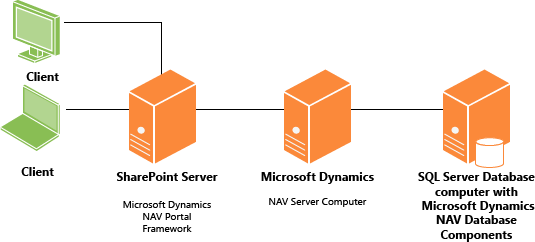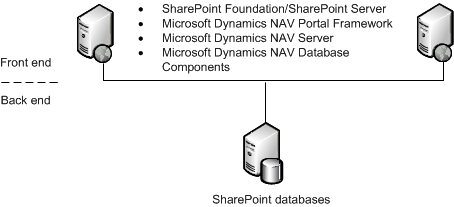This topic provides an overview of deploying the Microsoft Dynamics NAV SharePoint client and Microsoft Dynamics NAV Portal Framework for Microsoft SharePoint 2010.
- Deployment Scenarios
- User Authentication
- Service Account for Microsoft Dynamics NAV
Server and Database Access
- Securing the Connection to Microsoft
Dynamics NAV Portal Framework
Deployment Scenarios
To deploy the Microsoft Dynamics NAV SharePoint client, you install Microsoft Dynamics NAV Portal Framework on the computer that is running SharePoint Foundation Server or SharePoint Server. Like the Microsoft Dynamics NAV Windows client and Microsoft Dynamics NAV Web client, the Microsoft Dynamics NAV SharePoint client requires a connection to a Microsoft Dynamics NAV Server that connects to a Microsoft Dynamics NAV database on a Microsoft SQL Server.

The Microsoft Dynamics NAV Server and Microsoft SQL Server can be on the same computer as the Microsoft Dynamics NAV Portal Framework or different computers, depending on your hardware resources, network requirements, and the topology of your SharePoint deployment.
For more information, see How to: Install Microsoft Dynamics NAV Portal Framework.
 Important Important |
|---|
| You cannot use PowerShell to install the Microsoft Dynamics NAV Portal Framework. |
Supported SharePoint Topologies
In SharePoint network topology, tiers are used as the model for arranging farm servers according the components that they are running. SharePoint can be deployed in various network topologies to support the number of users, services, and applications that are required for your organization. The Microsoft Dynamics NAV SharePoint client is only supported in the following topologies:
- Stand-alone server or single-server farm
topology
In a stand-alone server or single-server farm deployment, the SharePoint Foundation Server or SharePoint Server and the database server are installed on one computer.
You must install the Microsoft Dynamics NAV Portal Framework on the web server that is running the SharePoint Foundation Server or SharePoint Server. You can install the Microsoft Dynamics NAV Server and the Microsoft Dynamics NAV database components on the same computer as the Microsoft Dynamics NAV Portal Framework or on separate computers. For an example about how to install Microsoft Dynamics NAV Server and the Microsoft Dynamics NAV database components on separate computers, see Walkthrough: Installing the Microsoft NAV Portal Framework Tiers on Multiple Computers - Two-tier farm topology
In a two-tier farm deployment, SharePoint Foundation Server or SharePoint Server and the SharePoint databases are installed on separate computers. The web servers are on the first tier, sometimes referred to as the front end, and the database server is located on the second tier, sometimes referred to as the database tier or back end.

The Microsoft Dynamics NAV Portal Framework, Microsoft Dynamics NAV Server, and Microsoft Dynamics NAV database components must be installed on the front end web server that is running the SharePoint Foundation Server or SharePoint Server.
Extranet and Other SharePoint Topologies
Extranet and other topologies that are supported by SharePoint Foundation Server and SharePoint are not supported by Microsoft Dynamics NAV 2013. You are not prevented from deploying the Microsoft Dynamics NAV SharePoint client in these topologies, however they have been not tested with Microsoft Dynamics NAV Portal Framework.
User Authentication
Microsoft Dynamics NAV Portal Framework supports Windows authentication for validating the identity of users who try to access Microsoft Dynamics NAV data from the Microsoft Dynamics NAV SharePoint client. Like the Microsoft Dynamics NAV Windows client, you restrict access to data by creating users in Microsoft Dynamics NAV and granting permissions to objects, such as pages and reports.
For more information, see Managing User Permissions for the Microsoft Dynamics NAV SharePoint Client.
Service Account for Microsoft Dynamics NAV Server and Database Access
When you install Microsoft Dynamics NAV Server and Microsoft Dynamics NAV database components, you must identify an Active Directory account to provide credentials for the servers. By default, Microsoft Dynamics NAV 2013 Setup runs Microsoft Dynamics NAV Server and the Microsoft Dynamics NAV database under the Network Service account, a predefined local account that is used by the service control manager.
We recommend that you create and use a domain user account for running Microsoft Dynamics NAV Server and accessing the Microsoft Dynamics NAV database. The Network Service account is considered less secure because it is a shared account that can be used by other unrelated network services.
For more information, see Provisioning the Microsoft Dynamics NAV Server Account.
Securing the Connection to Microsoft Dynamics NAV Portal Framework
You can help secure Microsoft Dynamics NAV data that is transmitted over the Internet by enabling Secure Sockets Layer (SSL) on the connection to Microsoft Dynamics NAV Portal Framework.
For more information, see Securing the Connection to Microsoft Dynamics NAV Portal Framework With SSL.
See Also
Tasks
How to: Deploy Microsoft Dynamics NAV Portal Framework on SharePoint Web Applications After InstallationConcepts
Configuring Microsoft Dynamics NAV Portal FrameworkManaging Languages and Regional Settings for the Microsoft Dynamics NAV SharePoint Client
Developing for the Microsoft Dynamics NAV SharePoint Client





